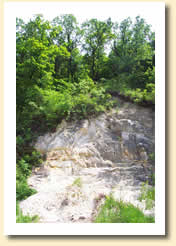![]()
Kasota Stone, mined across the river at Kasota, commonly overlies this layer. This rock (named the Oneonta Dolomite from the Ordovician Period) is 'missing' at Seven Mile Creek, likely eroded away by rivers that cut through this area prior to the great Ice Age.
From the top of the sandstone cliffs to the bluff's edge, the slopes are underlain by glacial deposits from the Pleistocene Epoch (the 'Great Ice Age'), which began about 2,000,000 years ago and ended 10,000 years ago. At numerous (perhaps 30) times during this epoch, glaciers formed in Canada and flowed southward. Many of these glaciers covered parts of Minnesota. Only a few (4 to 5) glaciations have left testimony to their presence in southern Minnesota. The most recent glacier, called the Des Moines Lobe, advanced across southern Minnesota 15,000 years ago, and melted back from here 12,000 years ago. This glacier left the rich loamy till of the region that has produced productive soils.
When the Des Moines Lobe retreated, it caused glacial Lake Agassiz to form in the Red River valley. The lake waters, unable to flow north because of the damming glacier, flowed south, gouging-out and cutting the great Minnesota River valley. The sudden trenching of this river valley caused its tributaries to form deep valleys and ravines. Seven Mile Creek is one of these tributaries. In the last 10,000 years, Seven Mile Creek has eroded downward through the till and the sandstone to its present grade. The trails in the park often traverse over small terraces that formed during the overall down cutting of Seven Mile Creek. In the creek bed can be seen many large boulders, once carried from Canada by the glaciers, now eroded out of the till by the creek and lining its banks.
Following the cessation
of the great river flowing from Lake Agassiz, the Minnesota River deposited
sediment and formed the broad flood plain seen in the main valley. As
the Minnesota River flood plain formed, it caused tributaries to deposit
sediment and create flood plains. From the park entrance to the trailhead
parking lot, a broad flood plain occurs, formed by Seven Mile Creek when
the Minnesota River formed its flood plain.
Today, Seven Mile Creek is continuing to shape the landscape, primarily
by eroding and shaping land at its headwaters. In time, Seven Mile Creek
will grow longer, dissecting and diminishing the flat-farmed plains that
start at the bluff tops. What will it look like in 1000 years? 10,000
years?
Text courtesy
of Mark Johnson, Professor of Geology, Gustavus Adolphus College.
BNC home | mrbdc home | web site map |
